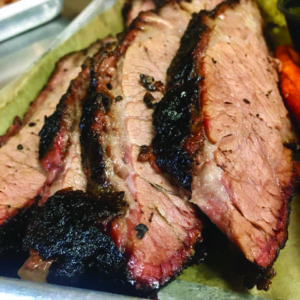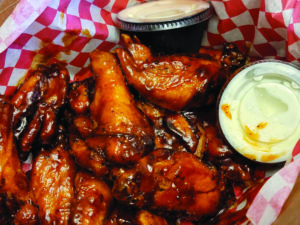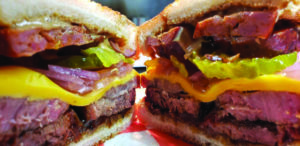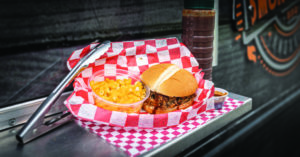Hometown BBQ
A Taste of the South in the Fox Cities
Summer is grilling season, and for many, grilling means barbecue. (Technically the two aren’t synonymous, but we won’t tell if you won’t!) Here in Wisconsin it means outdoor cooking and comfort food with southern roots. Literally it means cooking food over indirect heat with live fire and smoke.

The American barbecue (BBQ) tradition has origins in the Caribbean, and is inspired by Native Americans’ cooking methods that use smoke to roast food “low and slow.”
It began as a necessity and turned into a delicious discovery we’re still utilizing today.
“It was about taking cuts of meat that would normally be inedible and preparing them in a way to make them very good,” Travis Trader, co-owner of TTz BBQ in Menasha, says. “They called them butcher cuts. They had to figure out what to do with that meat.
“Brisket was one of them, and pork butts, which are actually the top part of the front shoulder. When you roasted it or cooked it over the fire, it turned out amazing.”
From sweet and salty to rich and tangy, barbecue in the United States differs as much as the people who eat it.
“I think barbecue is such a popular choice because of the lack of limitations with what you can call barbecue. It’s tender, it’s filling, it is sweet and salty,” Michael Ropella, co-owner of The Shop Bar & BBQ Grille in Appleton, says. “It is 100% comfort food. With all the individual components it’s really a ‘choose your own adventure.’”
Barbecue Style
BBQ philosophies and styles differ, but one thing holds true: there’s room for everyone and every style.
“True barbecue, to me, isn’t limited to meat,” Ropella says. “It is whatever you want to put in and cook at a low and slow temperature for an extended period of time, specifically trying to get that smoke flavoring into it.”
 Techniques and components range from temperature and wood to sauce and dry rubs. The style of barbecue indicates the region. Across the United States, the most well-known include Kansas City, Carolina, Memphis and Texas.
Techniques and components range from temperature and wood to sauce and dry rubs. The style of barbecue indicates the region. Across the United States, the most well-known include Kansas City, Carolina, Memphis and Texas.
“A lot of the styles, generally speaking, are kind of defined by how you put a rub on. What kind of sauce you use, or lack of sauce,” Ropella explains.
Kansas City: Sweet seasoning and slathered in a thick, sugary sauce. Kansas City style typically utilizes burnt ends, Kansas City bacon, ribs, brisket, pulled pork, chicken, and sausage.
Carolina: Slow-roasted whole hog and pulled pork shoulders barbecue using vinegar-based “mop sauce.”
Memphis: Slow-smoked, pulled, and served with a thin, tangy sauce on the side. Often includes wet ribs, dry ribs and pulled pork.
Texas: Oak-smoked brisket, sliced and served without sauce. Texas is known for brisket, beef ribs, pork ribs, and sausages.
While some pitmasters hold true to their BBQ style of choice, many in the Fox Cities take inspiration from the majors and put a spin to create their own:
“We do not marry ourselves to any region, instead we lean on many different regions for the products we serve,” Aaron and Jennifer Sloma, owners of Parker John’s BBQ, explains. “Our popular brisket is definitely Texas style where the Burnt Ends were a hybrid of both Kansas City and Wisconsin style flavor preferences. It’s hard in the BBQ world when you’re not from a specific region, to pledge allegiance to a certain BBQ style.”
“I’ve taken influences from a bunch of different styles,” Trader agrees. “My ribs are technically a dry rub, a Memphis style. Once they come off the smoker they go into a pan with ‘jus in it. They are wet, but they’re not sauced.”
“I learned most of what I know about barbecue in St. Louis. However, I’ve lived in a lot of places and my BBQ has been influenced a little bit by everywhere I’ve been,” Dan Couture, owner of Vincent’s Smokehouse, says.
“The barbecue sauce we use here, The Shop sauce, is a sweeter sauce. I don’t say we do a style. Really it’s “Fat Kid style,” whatever sounds good and tastes good!” Ropella laughs.
The Science of Smoke

While it’s hard to pinpoint exactly what makes barbecue so appealing, the type of wood—and thus smoke—used to cook the meat is at the top of the list every time.
Popular woods available in Wisconsin consist of “hardwoods,” maple, oak, hickory and fruit trees. Texas is home to mesquite and is known for the unique flavor.
The “low and slow” philosophy comes from the necessity to render fat, and allow time for the meat to become tender and smokey.
“When you truly start to dissect the science of smoking, the majority of your smoke flavor is going to be absorbed by the meat in the initial, beginning part of the cook,” Ropella says. “It’s about the first 4-6 hours where you’re truly going to get the majority of the flavor. From there, you’re cooking low and slow for the tenderness as well as the outside appearance, which is your bark.”
It may be why some are deciding to rebel against the typical standards of cooking barbecue.
“I don’t do low and slow anymore,” Trader divulges. “I do hot and fast. When you’re cooking the meat, you want the intermuscular fat to render, which it won’t do until about 165. It’s breaking down all of the fibers and that’s how it gets tender. Going too far, it will get mushy. Not going far enough will be tough.”
For example, Trader says, instead of cooking brisket at 225 for 16 hours, they’re doing it at 325 for 7 hours.
“I did a lot of research and worked up the courage and tried it,” he says. “I was blown away that the results were almost identical. You still get the smoke ring, the bark.”
“My BBQ philosophy is to keep it simple and be patient. I use old school drum smokers to get my desired flavors and stay vigilant on my temperatures,” Couture says. “BBQ needs a nice, deep smoke flavor without being overpowering. The meat should also be well-seasoned with a little kick at the end.”
 “We have a proprietary rub we use for each meat that is added prior to the smoking process,” Aaron and Jennifer Sloma say. “Your meat should be able to be served on its own, without sauce, for it to be true BBQ… a great sauce, served on the side, is also a component of BBQ.”
“We have a proprietary rub we use for each meat that is added prior to the smoking process,” Aaron and Jennifer Sloma say. “Your meat should be able to be served on its own, without sauce, for it to be true BBQ… a great sauce, served on the side, is also a component of BBQ.”
Wisconsin may not be known for its barbecue prowess (yet), but those on the Fox Cities scene say it’s a burgeoning one primed for growth, thanks in part to passion and support.
“BBQ should always be a comfort food that feeds your soul, while tasting the love that is put into it by the Pitmaster,” Reggie and Amanda Peters, owners of Peters’ Boyz Texas BBQ, say.
“It’s on the rise in the Valley,” Trader says. “The guys who are here are doing a good job. The area is big enough to support more, to support them all.”
“The spirit of barbecue is the camaraderie and the friendships,” Ropella adds. “Barbecue is about the connections, the networking. Go out and try everybody’s barbecue!”
The most popular dishes on the Fox Cities BBQ scene
Parker John’s: TX brisket and Pulled Pork. We literally sell north of a thousand pounds of each of these meats at each of our restaurants weekly. Our smoked chicken wings are literally flying off the shelves with thousands sold weekly on Wednesdays alone at each property.
Peters’ Boyz Texas BBQ: It varies, I would say our platters because you can try a little bit of everything we have to offer.

The Shop Bar & BBQ Grille: Chicken wings! We smoke ‘em and take it a step further and flash fry them. You get this smokey, complex flavor. Then you put sauce on it. A multitude of sauces changes the game. It makes it fun, it gives you a variety: whether you like sweet or spicy.
TTz BBQ: Sliced-to-Order Brisket. We don’t chop it, we just slice it. We do a regular–6 to 8 ounces and a piece of toast–and a large, which is 12-14 ounces and two pieces of toast. You get both point and flat, the two parts of the brisket.
Vincent’s Smokehouse: Pulled pork… along with our housemade mac n cheese. We also sell a lot of our Sweet Cheesus (a large mac topped with chicken, bacon and crumbled cornbread). Our Frito Pie special (fritos, topped with beans, pork, cheese and onions) is also really growing in popularity.










Leave a Comment